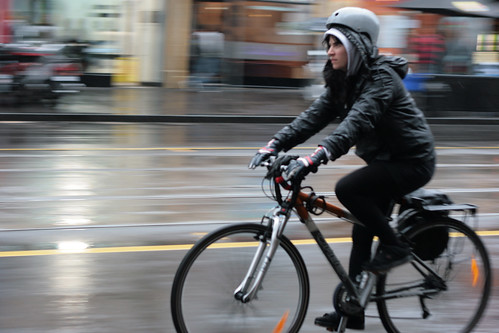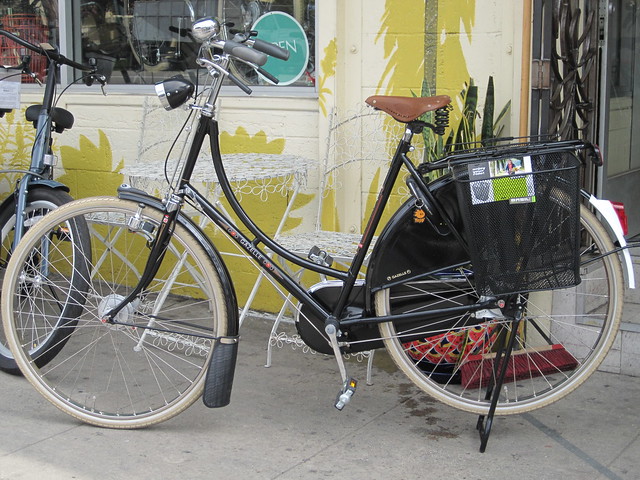
CC by 2.0: Flickr - Cory
Related Posts:
> See the "buying a bike and gear" category of this blog.
Details:
1. Why are fenders (mudguards) necessary for utility cyclists?
- If you depend on your bike for transport then you will want to have the option of riding all year round which includes when it rains or snows. Even if you typically choose not to ride when it is actually raining, you may wish to ride when the rain stops. However, the roads will often be wet during the rainy season.
- Without fenders or mudguards that sit over the back and front wheels to catch all the water and dirt being flicked up by the tyres, you will end up having your back, shoes and lower legs splattered with dirt and water.
- Sports or recreational cyclists often wear cycling clothes just for the ride itself and end up back home to clean up and get changed. As a result, racing bikes and mountain bikes generally don't come with fenders. On the other hand, utility cyclists arriving at a destination will not wish to be soaked or covered in dirt.
2. Why don't most utility bikes already come with fenders? Which ones do?
- In the few countries (the Netherlands, China) where a large proportion of people cycle for transport, fenders do come on almost all utility bikes. Unfortunately, in car-centric countries like Australia, most bikes sold are designed primarily for sport/ or recreation and fenders are considered uncool and extra weight. In car-centric countries, you need to search for "Dutch bikes" to get an idea of all the practical features a typical utility bike in the Netherlands comes with.
- Below is typical "Dutch bike" which comes with built-in fenders over the front and back wheel. Note also the additional wider flap at the bottom of the front fender. If a Dutch-style utility bike suits your needs and is within your budget then this is the easiest way to get suitable fenders - they'll always come with the bike.
- Dutch-style utility bikes best suit people riding short distances with few hills who don't wish to go too fast and will be wearing their normal clothes. To figure out if a Dutch-style bike is best for you see: What type of bike should I buy?

CC by 2.0: Flickr - Umberto Brayj
3. What if the bike I have or want doesn't come with fenders?
- Most utility cyclists will be in the situation of having a bike that doesn't have fenders built-in and realising they've got a problem when the roads are wet. Some are also aware of this problem when buying a bike but find the range of Dutch-style bikes available to them to not suit all of their needs (e.g. faster commuting, recreation) or be as affordable (they can be expensive where demand for cheaper varieties is low).
- Thus the practical challenge is how to find fenders or mudguards that will fit your bike and that will be effective, convenient and robust.
4. Fender and mudguard buying guides: how to pick the most suitable one
- General guidance on purchasing the right fender or mudguard for your bike and needs can be found on the below buying guides:
> eBay Buying Guides: Your Guide to Buying Bike Fenders
> Total Women's Cycling: What you need to know when buying bicycle mudguards
> Expert Village: How to Choose Fenders for Your Bike (video)
Essentials tips:
- The longer the fender and the closer it sits to the wheel the better.
- Most road, mountain and single speed bikes lack the eyelets on the frame to affix full-length fenders to. Clip-on fenders/mudguards are typically needed for these bikes.
- Make sure the fender or mudguard matches the wheel size and tyre width. A tyre will need a fender/mudguard that is wider than it.
- Many bikes, particularly road, mountain and single speed bikes, have limited clearance between the tyre, frame and brakes to fit fenders or mudguards. In these cases, you'll need to find a type that does fit the space you have available. If choosing a bike you'll want to fit fenders on, ensure it has sufficient clearance.
- If you want to protect your bike and clothing/shoes from spray you'll need full-length, close-fitting fenders. If you're mostly interested in protecting your clothing/shoes it may be feasible to use clip-on fenders that cover just those spray areas.
- Some fenders or mudguards you fit later to your bike can rattle, need regular realigning, rub the wheel or break. Ensuring you choose a robust, low-maintenance solution is important.
5. Key lessons from my fender and mudguard use
- I ride an inexpensive, steel, single speed and don't worry too much about my bike's drivetrain or components getting sprayed as I can clean it easily and it is a durable, cheap bike. If you have a bike with lots of gears which are harder to clean then full-length fenders are desirable.
- As I'm mainly interested in protecting my clothes and shoes I've found that suitable,clip-on mudguards over the rear wheel are very effective. The one I've used for years for the rear wheel with no splatter is the Zefal Swan which costs around $18.
Zefal Swan for Road-type bikes
- For clothing protection only, a solid rear rack over the back wheel is also an effective alternative to a rear fender or mudguard.
- Front wheel protection for shoes and lower-leg clothing is much trickier for bikes that come without full-length fenders. This is because the main spray area is right near the bottom closest to the pedals. Only the best front fenders with extra mudguard flaps really protect from this spray.

- I am still looking for a off-the-shelf front mudguard that I can attach to my bike and will actually be low and wide enough to be effective. Most of the clip-on front mudguards do not extend anywhere near enough to protect the main, front spray area. I will update this post if I find one.
- Generally, it is not critical for me to have a front mudguard as I often ride in shoes that are at least somewhat water resistant and dry out ok. The lower 6 inches of my jeans do get a bit wet from spray but they also dry out quickly enough.
- However, for winter riding I have created my own detachable, minimalist front mudguard out of a spare mountain bike mudguard (for the frame mount and directional joint) and the typical plastic from a seedling pot plant. This works quite wheel to protect my shoes and lower pants from the main spray area.
My bike with a Zefal Swan rear mudguard and a home-made front mudguard
- Riding speed makes a significant difference to the extent of spray from wheels. When the roads are particularly wet I ride a little slower so that there is less spray from my uncovered front wheel.
Further Info:
- Sheldon Brown: Fenders for your bicycle
- eBay Buying Guides: Your Guide to Buying Bike Fenders
- Road.cc: Buyer’s guide: Mudguards for keeping you dry this winter
- Bike Hacks: Fenders
- Why We Don’t Need Rain Bikes Any Longer







